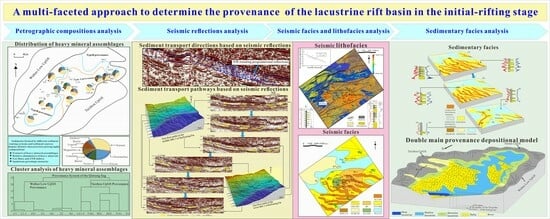A Multi-Faceted Approach to Determining the Provenance of the Lacustrine Rift Basin in the Initial Rifting Stage: A Case Study of the Paleocene Qintong Sag, Subei Basin, East China
Abstract
1. Introduction
2. Geological Setting
3. Data Collection and Analytical Methods
3.1. Data
3.2. Analytical Methods
4. Provenance Analysis
4.1. Provenance Identification
4.1.1. Features of Heavy Mineral Assemblages
4.1.2. Provenance Identification Based on Heavy Mineral Compositions
4.1.3. Provenance Identification Based on Relative Abundances of Heavy Minerals
4.2. Provenance Analysis Based on Sediment Transport Directions and Pathways
4.2.1. Sediment Transport Directions Based on ZTR Index
4.2.2. Sediment Transport Directions Based on Sandstone Petrologic Maturity
4.2.3. Sediment Transport Directions Based on Seismic Progradational Reflections
4.2.4. Provenance Analysis Based on Sediment Transport Pathways
5. Distribution Characteristics of Sedimentary Facies Controlled by Provenance
5.1. Interpretation of Seismic Facies and Lithofacies
5.2. Sedimentary Facies Analysis Using Well Logs and Seismic Facies
5.2.1. Delta Front Subfacies
5.2.2. Littoral-Shallow Lacustrine Subfacies
5.3. Provenance Analysis Based on Seismic Facies and Lithofacies
5.3.1. Distribution Characteristics of Seismic Facies and Lithofacies Controlled by Provenance in the Lower Third Member
5.3.2. Distribution Characteristics of Seismic Facies and Lithofacies Controlled by Provenance in the Middle Third Member
5.3.3. Distribution Characteristics of Seismic Facies and Lithofacies Controlled by Provenance in the Upper Third Member
5.4. Provenance Analysis Based on Sedimentary Facies
6. Double Main Provenance Depositional Model
7. Conclusions
Author Contributions
Funding
Data Availability Statement
Acknowledgments
Conflicts of Interest
References
- Zou, C.N.; Zhai, G.M.; Zhang, G.Y.; Wang, H.J.; Zhang, G.S.; Li, J.Z.; Wang, Z.M.; Zhang, G.S.; Li, J.Z.; Wang, Z.M.; et al. Formation, distribution, potential and prediction of global conventional and unconventional hydrcarbon resources. Petrol. Explor. Dev. 2015, 42, 14–28. [Google Scholar] [CrossRef]
- Dong, G.Y.; He, Y.B.; Leng, C.P.; Gao, F.L. Mechanism of sand body prediction in a continental rift basin by coupling paleogeomorphic elements under the control of base level. Petrol. Explor. Dev. 2016, 43, 579–590. [Google Scholar] [CrossRef]
- Li, Y.; Zhao, Y.N.; Lin, Z.L.; Ma, Q.L. Tectonic characteristics and structural styles of a continental rifted basin: Revelation from deep seismic reflection profiles. Geod. Geodyn. 2016, 7, 329–339. [Google Scholar] [CrossRef]
- Zheng, M.; Li, J.Z.; Wu, X.Z.; Wang, S.J.; Guo, Q.L.; Yu, J.D.; Zheng, M.; Chen, N.S.; Yi, Q. China’s conventional and unconventional natural gas resources: Potential and exploration targets. J. Nat. Gas Geosci. 2018, 3, 295–309. [Google Scholar] [CrossRef]
- Li, Y.; Fan, A.P.; Yang, R.C.; Lash, G.; Bilal, A.; Chen, J. A multi-faceted approach to determine the provenance of Eocene converging deltas, Dongying Depression, Bohai Bay Basin (E China). Mar. Petrol. Geol. 2022, 14, 105692. [Google Scholar] [CrossRef]
- Lagabrielle, Y.; Asti, R.; Duretz, T.; Clerc, C.; Fourcade, S.; Teixell, A.; Labaume, P.; Corre, B.; Saspiturry, N. A review of cretaceous smooth-slopes extensional basins along the Iberia-Eurasia plate boundary: How pre-rift salt controls the modes of continental rifting and mantle exhumation. Earth-Sci. Rev. 2020, 201, 103071. [Google Scholar] [CrossRef]
- Goswami, S.; Ghosh, P. Evolution of sedimentation pattern in a continental rift basin of India, between the Late Triassic and the early Middle Jurassic: Tectonic and climatic controls. Sediment. Geol. 2020, 405, 105679. [Google Scholar] [CrossRef]
- Yang, X.B.; Wang, H.Y.; Li, Z.Y.; Guan, C.; Wang, X. Tectonic-sedimentary evolution of a continental rift basin: A case study of the Early Cretaceous Changling and Lishu fault depressions, southern Songliao Basin, China. Mar. Petrol. Geol. 2021, 128, 105068. [Google Scholar] [CrossRef]
- Li, Y.A.; Lin, S.K.; Wang, S.; Wang, Y.M.; Xie, S.X. Depositional cycles in a rift lacustrine basin linked with tectonics, climate, and source rocks and reservoirs development: Lower Cretaceous in Naiman sag, Songliao Basin, Inner Monglia, Northeast China. Mar. Petrol. Geol. 2023, 155, 106348. [Google Scholar] [CrossRef]
- Bárbara, M.N.; Ricardo, A.; Fernando, J.; Norberto, M.; Márcio, M.; Pimentel, M.M. Source-to-sink analysis of continental rift sedimentation: Triassic Cuyo basin, Precordillera Argentina. Sediment. Geol. 2018, 376, 164–184. [Google Scholar] [CrossRef]
- Xie, Z.K. Sequence boundaries and regularities in the oil–gas distribution of the low swelling slope belt in the continental rift basin. Min. Sci. Technol. 2011, 21, 419–425. [Google Scholar] [CrossRef]
- Yu, N.T.; Teng, L.S.; Chen, W.S.; Yue, L.F.; Chen, M.M. Early post-rift sequence stratigraphy of a Mid-Tertiary rift basin in Taiwan: Insights into a siliciclastic fill-up wedge. Sediment. Geol. 2013, 286–287, 39–57. [Google Scholar] [CrossRef]
- Li, Q.; Zhang, Z.L.; Zhang, J. Characteristics of sedimentary differential response for multi-episode rifting cycles in lacustrine rift basin: A case study of the Palaeogene Baxian sag in the Bohai Bay Basin. Mar. Petrol. Geol. 2022, 136, 2022–105426. [Google Scholar] [CrossRef]
- Wang, R.; Ji, Y.L.; Colombera, L.; Mountney, N.P.; Yuan, B.; Li, D.J.; Song, H.Y.; Zhou, S. Axial and transverse depositional systems of a syn-rift basin fill (Bohai Bay Basin, China). Mar. Petrol. Geol. 2021, 128, 105045. [Google Scholar] [CrossRef]
- Almeida, R.P.; Liliane, J.; Fragoso-Cesar, A.R.S.; Marconato, A. Evolution of a rift basin dominated by subaerial deposits: The Guaritas Rift, Early Cambrian, Southern Brazil. Sediment. Geol. 2009, 217, 30–51. [Google Scholar] [CrossRef]
- Li, C.X.; Liu, Z.; Wang, S.C.; Xu, Z.Y.; Chen, S.G.; You, X.L.; Wang, B. Prediction of major source rocks distribution in the transition from depressed to rifted basin using seismic and geological data: The Guyang to Linhe Formations in the Linhe Depression, Hetao Basin, China. J. Petrol. Sci. Eng. 2022, 214, 110472. [Google Scholar] [CrossRef]
- Yang, K.; Zhu, X.M.; Colombera, L.; McArthur, A.; Mountney, M.P.; Zhu, S.F.; Jin, L.; Shen, T.T.; Yang, H.Y.; Chen, H.K.; et al. Sediment provenance and dispersal in the early Eocene Dongying Depression, Bohai Bay Basin, Eastern China: Evidence from detrital zircon geochronology, geochemistry and petrology. Sediment. Geol. 2023, 454, 106453. [Google Scholar] [CrossRef]
- Song, Y.; Ren, J.Y.; Liu, K.Y.; Lyu, D.W.; Feng, X.J.; Liu, Y.; Stepashko, A. Syn-rift to post-rift tectonic transition and drainage reorganization in continental rifting basins: Detrital zircon analysis from the Songliao Basin, NE China. Geosci. Front. 2022, 13, 101377. [Google Scholar] [CrossRef]
- Rukavina, D.; Saftić, B.; Matoš, B.; Močilac, I.K.; Fuček, V.P.; Cvetković, M. Tectonostratigraphic analysis of the syn-rift infill in the Drava Basin, southwestern Pannonian Basin System. Mar. Petrol. Geol. 2023, 152, 106235. [Google Scholar] [CrossRef]
- Andersen, T. Detrital zircons as tracers of sedimentary provenance: Limiting conditions from statistics and numerical simulation. Chem. Geol. 2005, 216, 249–270. [Google Scholar] [CrossRef]
- Triebold, S.; Eynatten, V.H.; Zack, T. A recipe for the use of rutile in sedimentary provenance analysis. Sediment. Geol. 2012, 282, 268–275. [Google Scholar] [CrossRef]
- O’Sullivan, G.; Chew, D.; Kenny, G.; Henrichs, I.; Mulligan, D. The trace element composition of apatite and its application to detrital provenance studies. Earth-Sci. Rev. 2020, 201, 103044. [Google Scholar] [CrossRef]
- Wu, Q.; Yu, W.R.; Luo, W.F.; Zang, S.H.; Zang, L.; Wu, W. Achievements and recognitions of exploration in lithologic reservoirs in Qintong sag, North Jiangsu Basin. China. Petrol. Explor. 2016, 21, 99–107, (In Chinese with English Abstract). [Google Scholar] [CrossRef]
- Zhang, P.F.; Yin, Y.J.; Lu, S.F.; Wang, J.J.; Zhang, J.J.; Zhi, Q.; Huang, H.S. Key factors controlling oil contents in different lithofacies shales from the Funing Formation, Subei Basin: Evidence from scanning electron microscopy. Geoenergy Sci. Eng. 2023, 229, 212115. [Google Scholar] [CrossRef]
- Chen, J.W.; Xu, M.; Lei, B.H.; Liang, J.; Zhang, Y.G.; Wu, S.Y.; Shi, J.; Yuan, Y.; Wang, J.Q.; Zhang, Y.X.; et al. Prospective prediction and exploration situation of marine Mesozoic-Paleozoic oil and gas in the South Yellow Sea. China Geol. 2019, 2, 67–84. [Google Scholar] [CrossRef]
- Cai, L.X.; Zhang, X.H.; Guo, X.W.; Zeng, Z.G.; Xiao, G.L.; Pang, Y.M.; Wang, S.P. Effective hydrocarbon-bearing geological conditions of the Permian strata in the South Yellow Sea Basin, China: Evidence from borehole CSDP-2. J. Petrol. Sci. Eng. 2021, 196, 107815. [Google Scholar] [CrossRef]
- Zhang, G.H.; Zan, N. The rules of hydrocarbon enrichment in the 3(rd) member of Funing formation on the west steep slope of Qintong depression of Subei basin. J. Yangtze Univ. Nat. Sci. Ed. 2016, 13, 13–17, (In Chinese with English Abstract). [Google Scholar] [CrossRef]
- Zhao, S.J.; Fu, Q.; Lou, W.F.; Huang, J.L.; Teng, J. The hydrocarbon accumulation regularity and the model of hydrocarbon accumulation along the fault ridges in the slope zone of the continental fault basin. J. Petrol. Sci. Eng. 2022, 208, 109188. [Google Scholar] [CrossRef]
- Fan, Z.Y.; Zhao, J.R.; Pan, S.Z.; Ma, C.J.; Qu, M.X.; Hai, Y.; Deng, X.G. Study on the basement structure in the southeastern North China by blasting seismic. Geod. Geodyn. 2018, 9, 312–319. [Google Scholar] [CrossRef]
- Liu, X.P.; Lai, J.; Fan, X.C.; Shu, H.L.; Wang, G.C.; Ma, X.Q.; Liu, M.C.; Guan, M.; Luo, Y.F. Insights in the pore structure, fluid mobility and oiliness in oil shales of Paleogene Funing Formation in Subei Basin, China. Mar. Petrol. Geol. 2020, 114, 104228. [Google Scholar] [CrossRef]
- Zhang, F.Q.; Dilek, Y.; Chen, H.L.; Yang, S.F.; Meng, Q.A. Structural architecture and stratigraphic record of Late Mesozoic sedimentary basins in NE China: Tectonic archives of the Late Cretaceous continental margin evolution in East Asia. Earth-Sci. Rev. 2017, 171, 598–620. [Google Scholar] [CrossRef]
- Liu, J.S.; Ding, W.L.; Gu, Y.; Xiao, Z.K.; Dai, J.S.; Dai, P.; Chen, X.S.; Gang Zhao, G. Methodology for predicting reservoir breakdown pressure and fracture opening pressure in low-permeability reservoirs based on an in situ stress simulation. Eng. Geol. 2018, 246, 222–232. [Google Scholar] [CrossRef]
- Luo, H.; Xu, X.W.; Gao, Z.W.; Liu, X.L.; Yu, H.M.; Wu, X.Y. Spatial and temporal distribution of earthquake ruptures in the eastern segment of the Altyn Tagh fault, China. J. Asian Earth Sci. 2019, 173, 263–274. [Google Scholar] [CrossRef]
- Cheng, Y.J.; Wu, Z.P.; Xu, B.; Dai, Y.N.; Chu, Y.C.; Zhang, J.; Chen, M.M.; Ma, S.T.; Sun, W.J.; Xu, L.L. The Mesozoic tectonic evolution of the East China Sea Basin: New insights from 3D seismic reflection data. Tectonophysics 2023, 848, 229717. [Google Scholar] [CrossRef]
- Han, Z.H.; Cheng, X.C.; Guo, H.H.; Pang, L.Y. Accumulation and Mixing of Oils in Jinghu Sag of Subei Basin: Constraints from Thermal Maturity Parameters. J. China Univ. Min. Technol. 2007, 17, 53–57. [Google Scholar] [CrossRef]
- Zhou, X.W.; Jiang, Z.X.; Quaye, J.A.; Duan, Y.; Hu, C.L.; Liu, C.; Han, C. Ichnology and sedimentology of the trace fossil-bearing fluvial red beds from the lowermost member of the Paleocene Funing Formation in the Jinhu Depression, Subei Basin, East China. Mar. Petrol. Geol. 2019, 99, 393–415. [Google Scholar] [CrossRef]
- Zhang, R.Y.; Yang, F.Y.; Hu, P.P.; Yang, X.D.; Peng, Y.X. Cenozoic tectonic inversion in the Northern Depression, South Yellow Sea Basin, East Asia: Structural styles and driving mechanism. Tectonophysics 2021, 798, 228687. [Google Scholar] [CrossRef]
- Zhao, L.Q.; Qin, H.M.; Yu, C.Q.; Si, C.N.; Jiang, W.; Cao, A.F. A new understanding of Jurassic provenance and sedimentary framework in northwestern Sikeshu Sag, Junggar Basin, China. Energy Geosci. 2022, 3, 372–380. [Google Scholar] [CrossRef]
- Sun, Y.J.; Wang, H.B.; Huang, Y.; Wang, J.F.; Jiang, H.L.; He, Y.C.; Huang, Z.C. Insight into seismotectonics of the central-south Tanlu Fault in East China from P-wave tomography. J. Asian Earth Sci. 2023, 258, 105722. [Google Scholar] [CrossRef]
- Liang, J.; Zhang, P.H.; Chen, J.W.; Gong, J.N.; Yuan, Y. Hydrocarbon preservation conditions in Mesozoic–Paleozoic marine strata in the South Yellow Sea Basin. Nat. Gas Ind. B 2017, 4, 432–441. [Google Scholar] [CrossRef]
- Hu, S.Z.; Song, Y.; Su, P.; Mahlstedt, N.; Mangelsdorf, K.; Shen, C.B.; Li, S.F.; Zhu, K. Impact of marine incursions on lacustrine source rocks: Organic matter quantity, quality, and kinetics in the Paleocene South Yellow Sea Basin, offshore eastern China. Org. Geochem. 2020, 148, 104084. [Google Scholar] [CrossRef]
- Liu, C.; Jiang, Z.X.; Zhou, X.W.; Duan, Y.; Huarui, L.; Xu, Y.; Wang, X.Y.; Quaye, J.A. Paleocene storm-related event beds in the Gaoyou Sag of the Subei Basin, eastern China: A new interpretation for these deep lacustrine sandstones. Mar. Petrol. Geol. 2021, 124, 104850. [Google Scholar] [CrossRef]
- Wu, Z. Depositional characteristics and sand bodies distribution of thrid member of Funing formation in Yinzhuang-Taixing Block, Qintong sag in the north Jiangsu. J. Geol. 2011, 35, 29–32, (In Chinese with English Abstract). [Google Scholar] [CrossRef]
- Cai, L.X.; Guo, X.W.; Zhang, X.H.; Zeng, Z.G.; Xiao, G.L.; Pang, Y.M.; Wang, S.P. Pore-throat structures of the Permian Longtan Formation tight sandstones in the South Yellow Sea Basin, China: A case study from borehole CSDP-2. J. Petrol. Sci. Eng. 2020, 186, 106733. [Google Scholar] [CrossRef]
- Pang, Y.M.; Guo, X.W.; Chang, X.C.; Zhang, J.J.; Zhou, J.Q.; Cai, L.X. Characteristics and classification of paleozoic tight reservoirs in the central uplift of the South Yellow Sea Basin. Energy. Geosci. 2020, 3, 383–393. [Google Scholar] [CrossRef]
- Wang, K.S.; Shi, X.F.; Yao, Z.Q.; Liu, J.X.; Liu, J.; Xu, T.X. Heavy-mineral-based provenance and environment analysis of a Pliocene series marking a prominent transgression in the south Yellow Sea. Sediment. Geol. 2019, 382, 25–35. [Google Scholar] [CrossRef]
- Zhu, X.F.; Shen, C.B.; Zhou, R.J.; Xu, J.Y.; Zhao, J.X.; Wang, L.; Ge, X. Paleogene sediment provenance and paleogeographic reconstruction of the South Yellow Sea Basin, East China: Constraints from detrital zircon U-Pb geochronology and heavy mineral assemblages. Palaeogeogr. Palaeocl. 2020, 553, 109776. [Google Scholar] [CrossRef]
- Zhao, S.J.; FU, Q.; Luo, W.F.; Huang, J.L.; Teng, J. Sedimentary characteristics of sandy beach-bar in faulted-lacustrine-basin, Ef3 in west slope of Qintong Sag. Reserv. Eval. Dev. 2021, 11, 248–255, (In Chinese with English Abstract). [Google Scholar] [CrossRef]
- Nesbitt, H.W.; Young, G.M.; McLennan, S.M.; Keays, R.R. Effects of Chemical Weathering and Sorting on the Petrogenesis of Siliciclastic Sediments, with Implications for Provenance Studies. J. Geol. 1996, 104, 525–542. [Google Scholar] [CrossRef]
- Weltje, G.J.; Eynatten, H.V. Quantitative provenance analysis of sediments: Review and outlook. Sediment. Geol. 2004, 171, 1–11. [Google Scholar] [CrossRef]
- Caracciolo, L. Sediment generation and sediment routing systems from a quantitative provenance analysis perspective: Review, application and future development. Earth-Sci. Rev. 2020, 209, 103226. [Google Scholar] [CrossRef]
- Morton, A.C.; Hallsworth, C.R. Identifying provenance-specific features of detrital heavy mineral assemblages in sandstones. Sediment. Geol. 1994, 90, 241–256. [Google Scholar] [CrossRef]
- Hubert, J.F. A zircon-tourmaline-rutile maturity index and the interdependence of the composition of heavy minerals assemblages with the gross composition and texture of sandstones. J. Sediment. Res. 1962, 32, 440–450. [Google Scholar] [CrossRef]
- Morton, A.C.; Hallsworth, C.R. Processes controlling the composition of heavy mineral assemblages in sandstones. Sediment. Geol. 1999, 124, 3–29. [Google Scholar] [CrossRef]
- Blatt, H. Provenance determinations and recycling of sediments. J. Sediment. Petrol. 1967, 37, 1031–1044. [Google Scholar] [CrossRef]
- Ferree, R.A.; Jordan, D.W.; Kertes, R.S.; Savage, M.; Potter, P.E. Comparative petrographic maturity of river and beach sand, and origin of quartz arenites. J. Geol. Educ. 1988, 36, 79–87. [Google Scholar] [CrossRef]
- Garzanti, E. The maturity myth in sedimentology and provenance analysis. J. Sediment. Res. 2017, 87, 353–365. [Google Scholar] [CrossRef]
- Yao, Z.Q.; Yang, F.; Jianatayi, D.N.T.Y.; Wang, W.; Gao, Y.; Sun, L.; Wang, W.F.; Mu, B.Y.; Pin, B.P. Application of multi-attribute matching technology based on geological models for sedimentary facies: A case study of the 3rd member in the Lower Jurassic Badaowan Formation, Hongshanzui area, Junggar Basin, China. Petrol. Sci. 2022, 19, 116–127. [Google Scholar] [CrossRef]
- Liu, Q.H.; Zhu, H.T.; Shu, Y.; Zhu, X.M.; Yang, X.H.; Chen, L.; Tan, M.X.; Geng, M.Y. Provenance identification and sedimentary analysis of the beach and bar systems in the Palaeogene of the Enping Sag, Pearl River Mouth Basin, South China Sea. Mar. Petrol. Geol. 2016, 70, 251–272. [Google Scholar] [CrossRef]
- Liu, Z. Reservoir Seismic Stratigraphy; Geological Press: Baijing, China, 1997; pp. 1–257, (In Chinese with English Abstract). [Google Scholar]
- Luo, L.M. Three Dimensional High Resolution Sequence Stratigraphy of River and Lake Sedimentary Systems; Geological Press: Beijing, China, 1999; pp. 1–187, (In Chinese with English Abstract). [Google Scholar]
- Brown, A.R. Interpretation of three-dimensional seismic data. AAPG Mem. 2011, 42, 1–309. [Google Scholar] [CrossRef]
- Abbas, A.; Zhu, H.T.; Zeng, Z.W.; Zhou, X.H. Sedimentary facies analysis using sequence stratigraphy and seismic sedimentology in the Paleogene Pinghu Formation, Xihu Depression, East China Sea Shelf Basin. Mar. Petrol. Geol. 2018, 93, 287–297. [Google Scholar] [CrossRef]
- Xu, G.Q.; Zhang, L.; Pang, X.; Chen, M.; Xu, S.H.; Liu, B.J.; Zuo, Y.H.; Luo, S.B.; Hu, L.; Chen, H.; et al. New method for the reconstruction of sedimentary systems including lithofacies, environments, and flow paths: A case study of the Xisha Trough Basin, South China Sea. Mar. Petrol. Geol. 2021, 133, 105268. [Google Scholar] [CrossRef]
- Xu, G.Q.; Haq, B.U. Seismic facies analysis: Past, present and future. Earth-Sci. Rev. 2022, 224, 103876. [Google Scholar] [CrossRef]
- Su, Z.; Liu, Y.F.; Han, J.F.; Han, J.F.; Lou, H.N.; Yang, F.Y.; Cui, Y.Z.; Peng, P.; Zhang, H.F.; Du, L.; et al. Application of ultra-deep sandstone reservoirs prediction technology under controlled seismic facies in Yudong block of Tabei Uplift, Tarim Basin, China. J. Nat. Gas Geosci. 2020, 5, 157–167. [Google Scholar] [CrossRef]
- Wu, W.; Li, Q.; Pei, J.X.; Ning, S.Y.; Tong, L.Q.; Liu, W.Q.; Feng, Z.D. Seismic sedimentology, facies analyses, and high-quality reservoir predictions in fan deltas: A case study of the Triassic Baikouquan Formation on the western slope of the Mahu Sag in China’s Junggar Basin. Mar. Petrol. Geol. 2020, 120, 104546. [Google Scholar] [CrossRef]
- Yao, G.S.; Yuan, S.Q.; Wu, S.G.; Zhong, C. Double provenance depositional model and exploration prospect in the deep-water area of Qiongdongnan Basin. Petrol. Exp. Dev. 2008, 35, 685–691. [Google Scholar] [CrossRef]
- Sun, W. Log interpretation method and application for 3rd member of Funing formation in west slope of Qintong sag. Pet. Reserv. Eval. Dev. 2020, 10, 121–125, (In Chinese with English Abstract). [Google Scholar] [CrossRef]

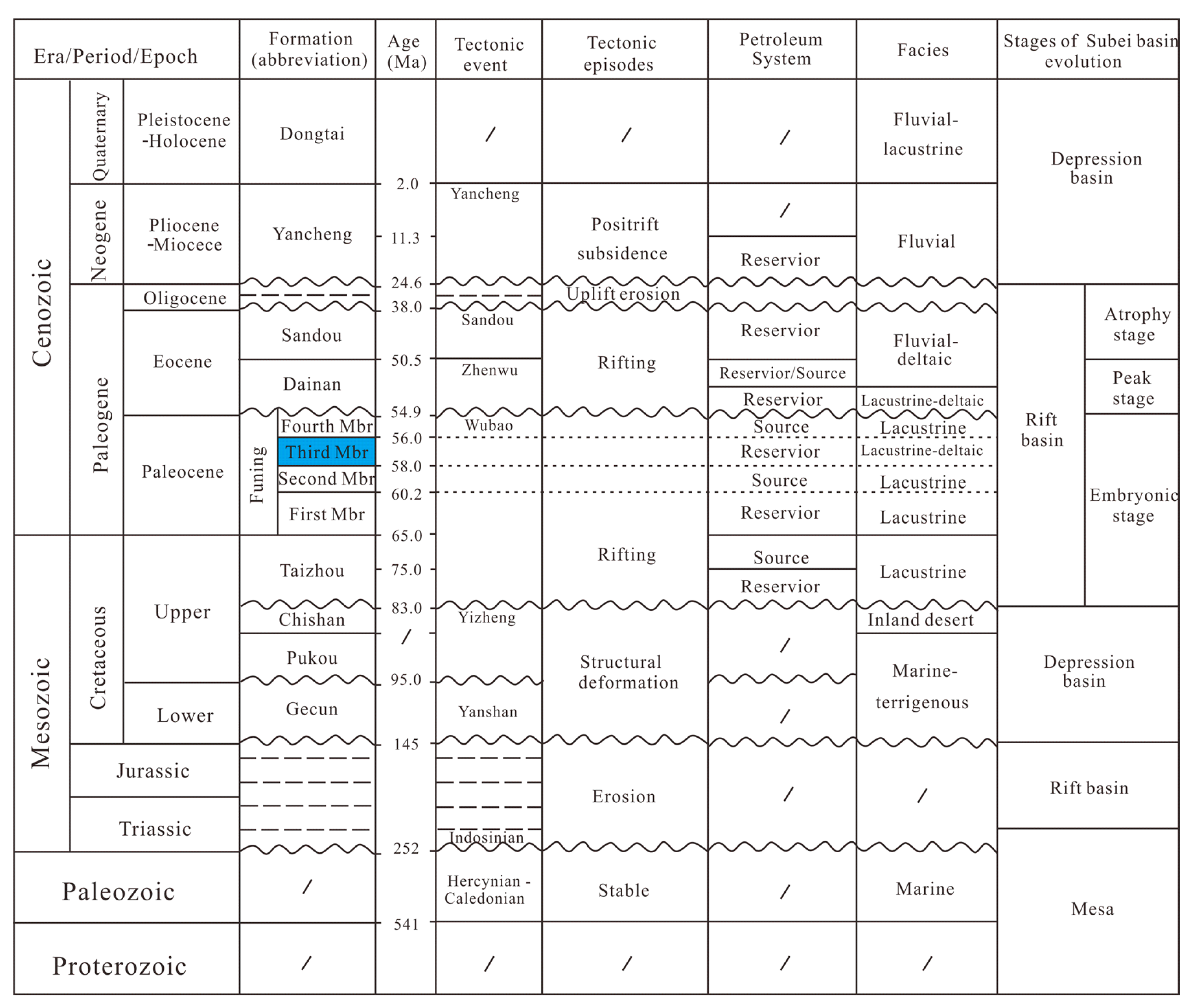
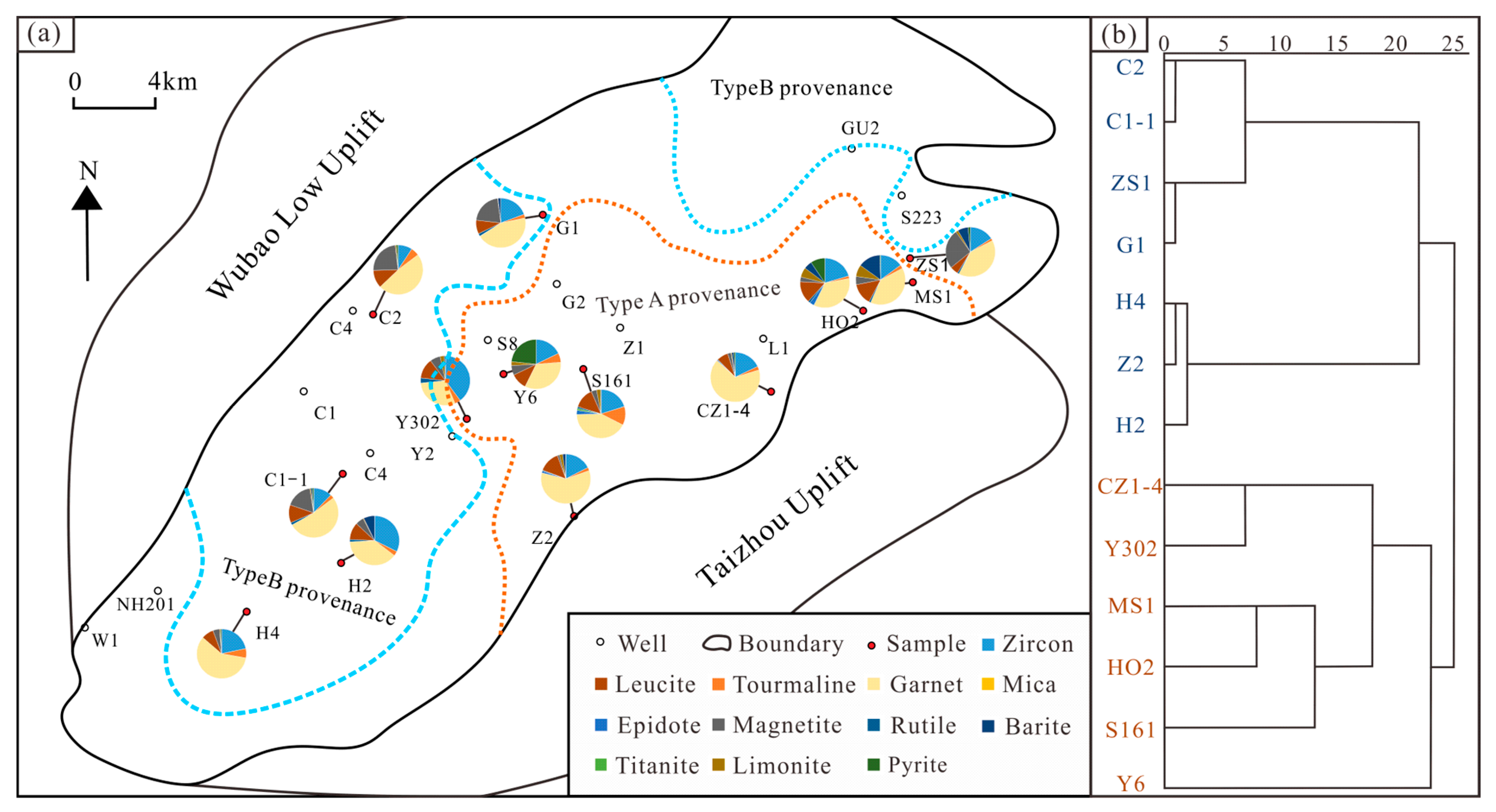
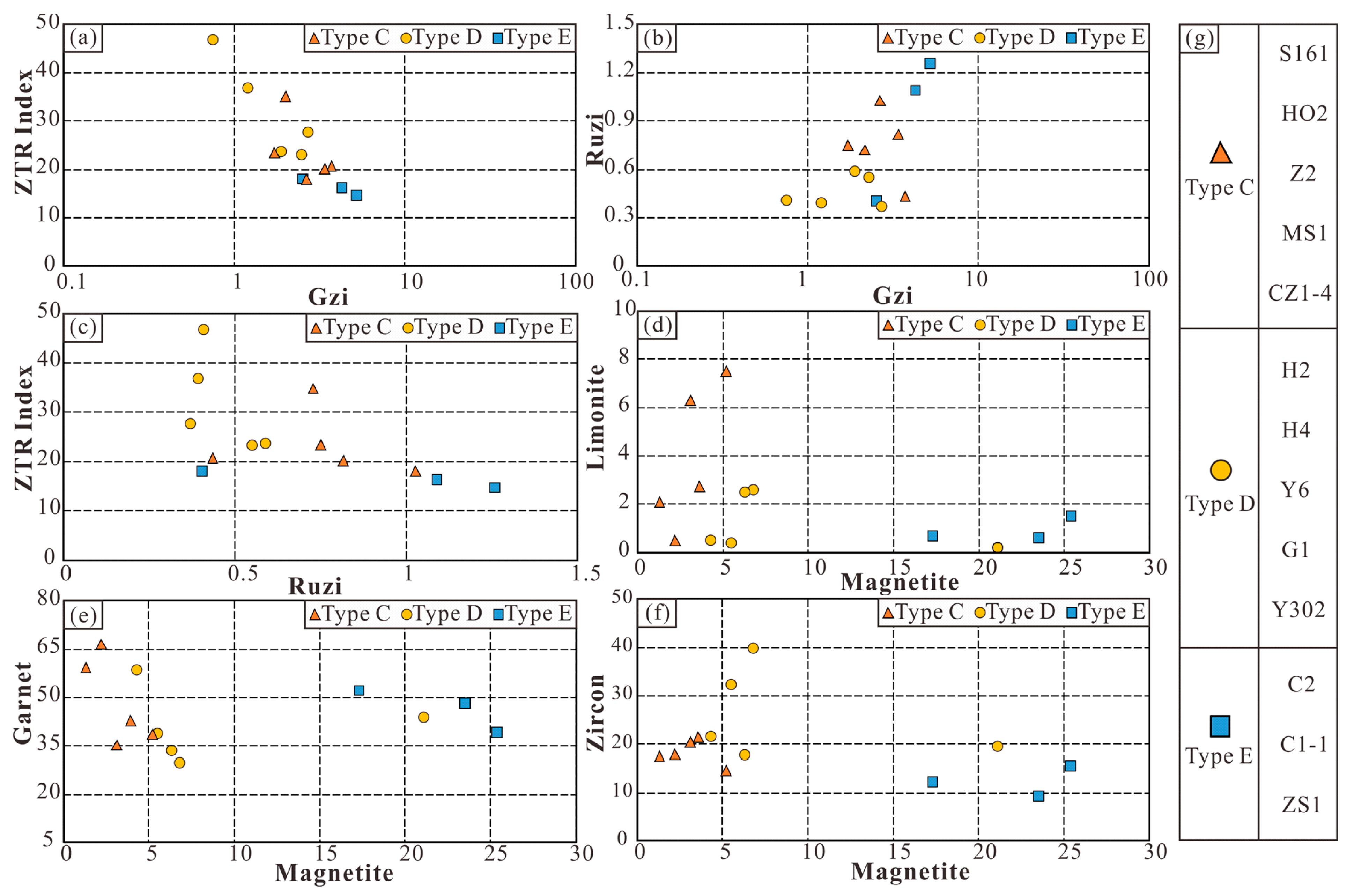


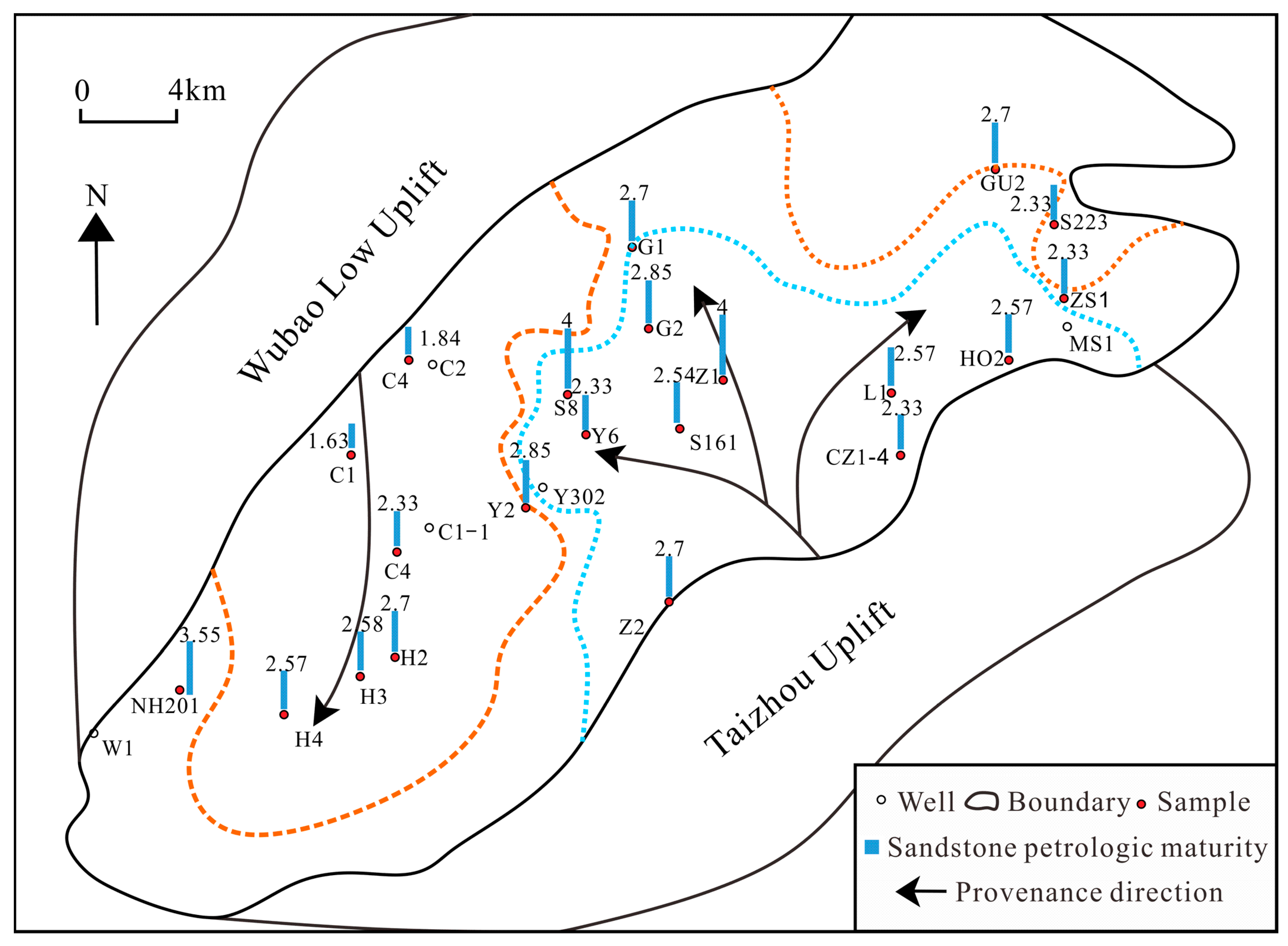
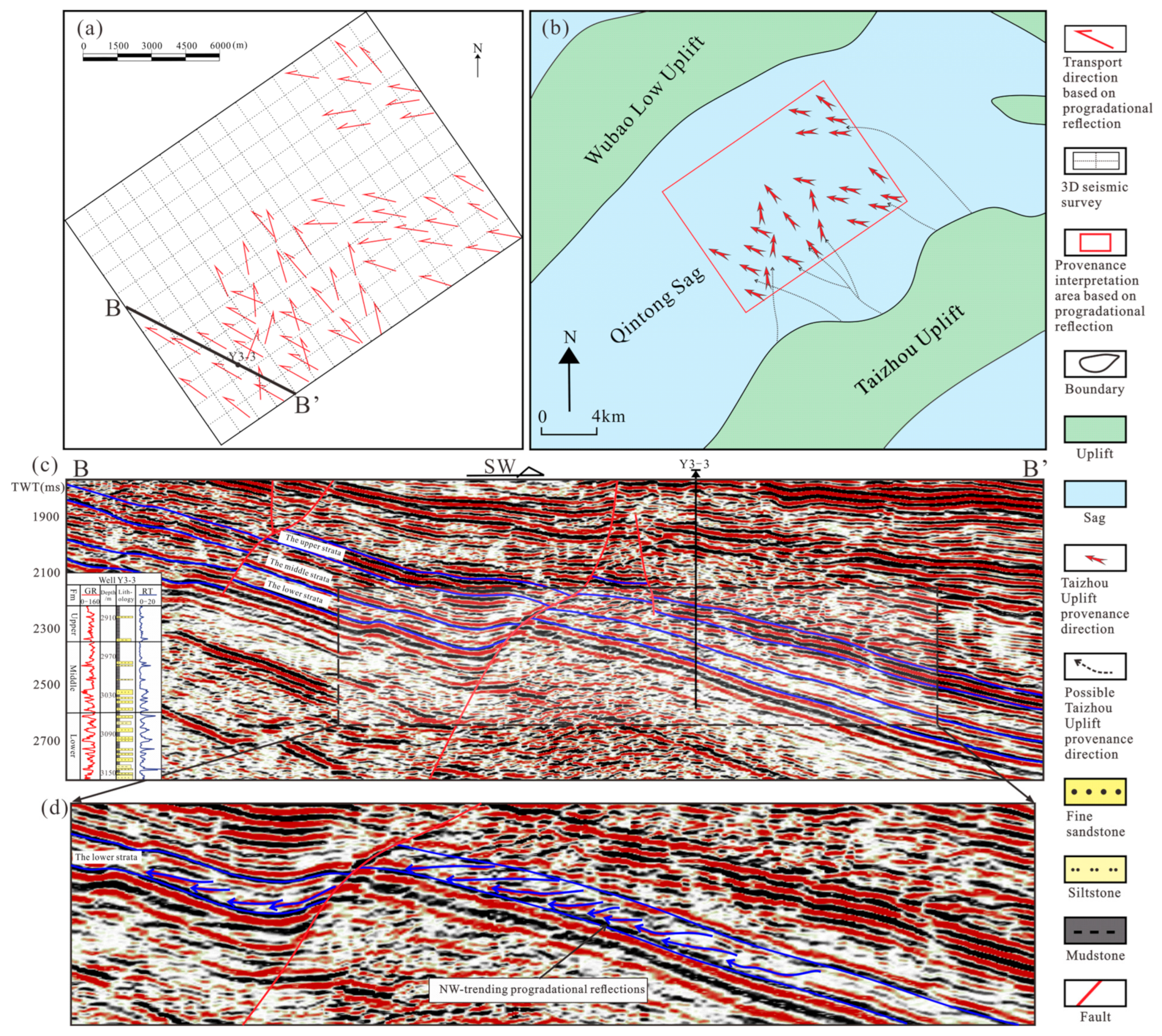
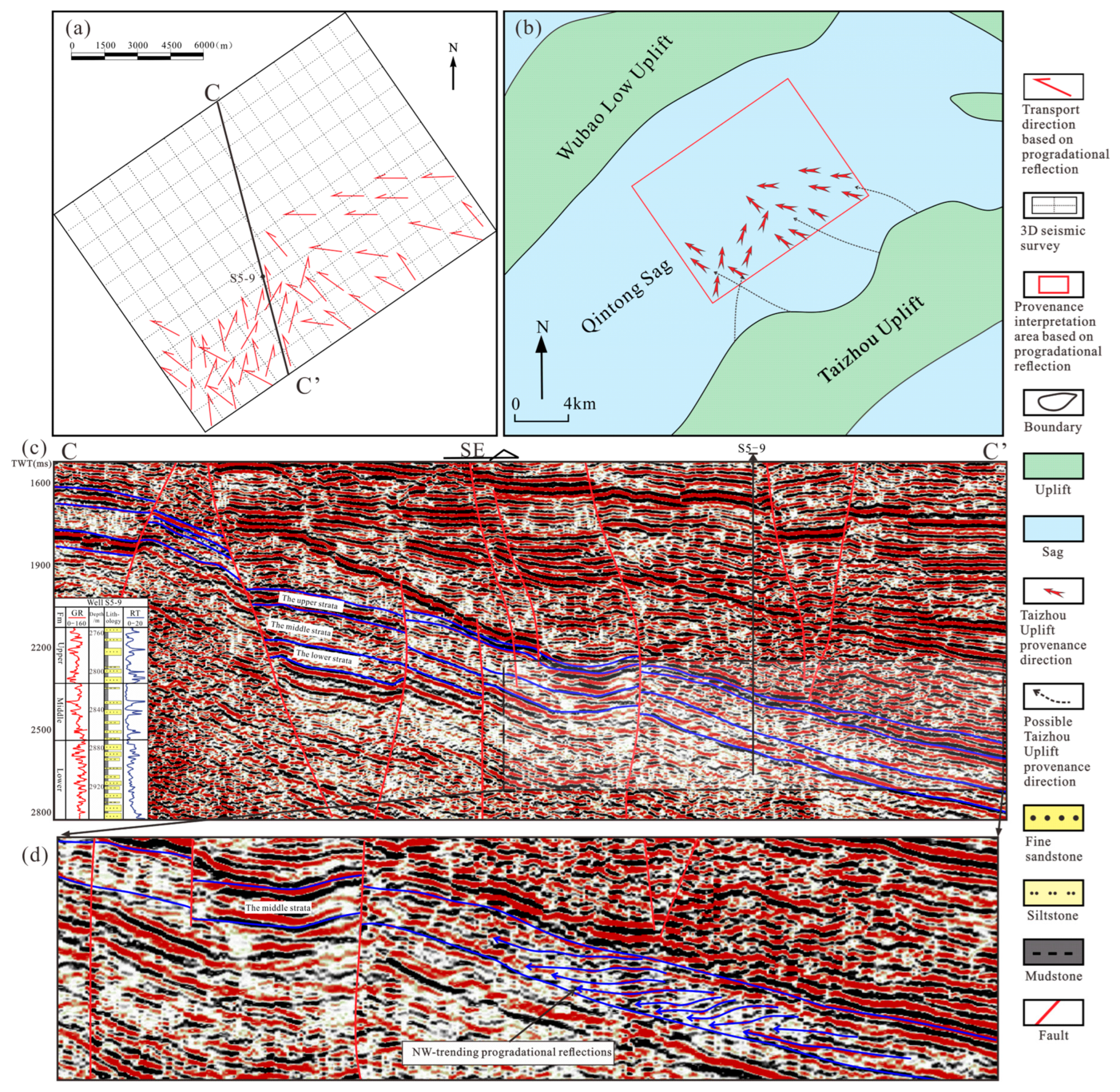

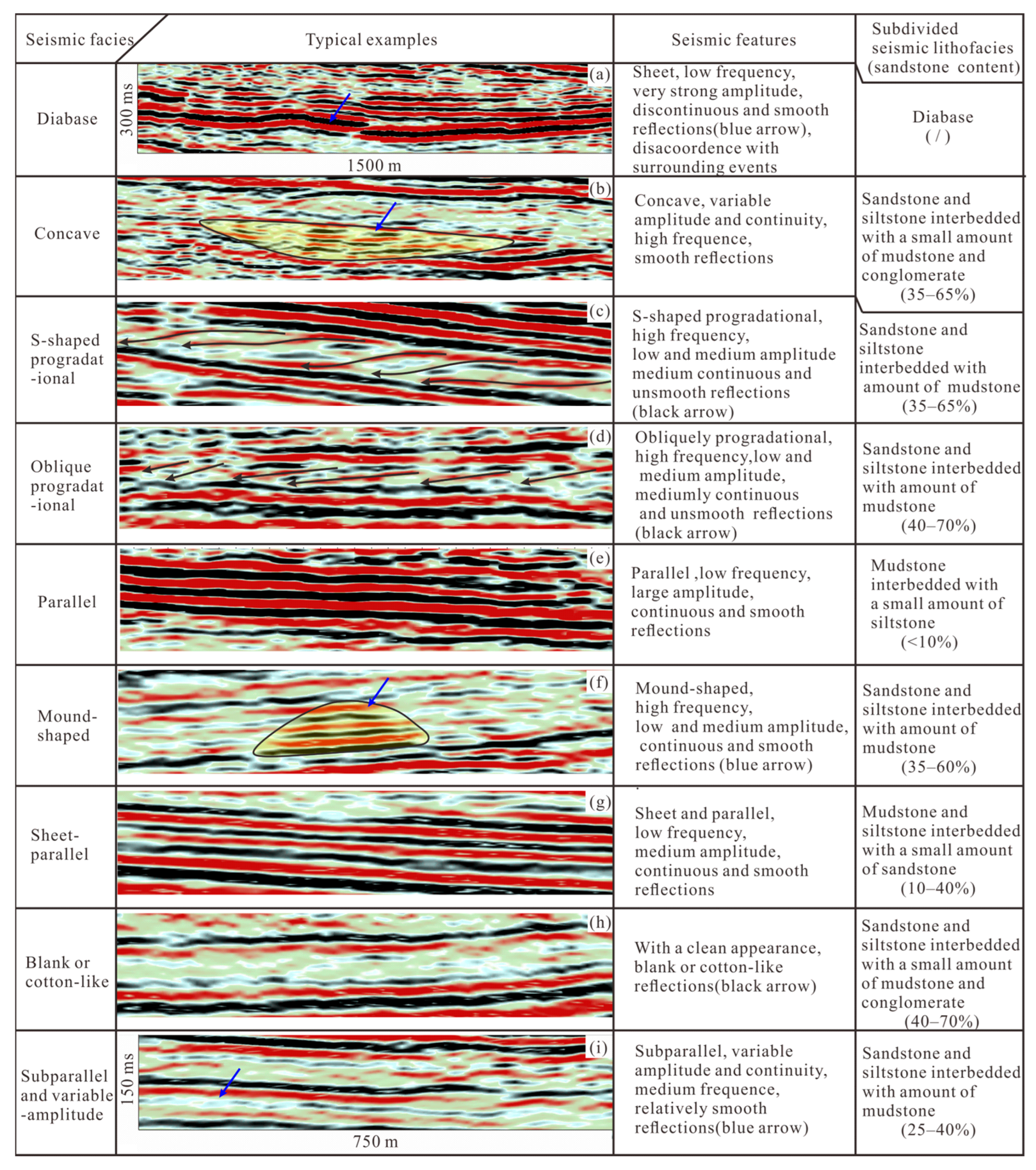
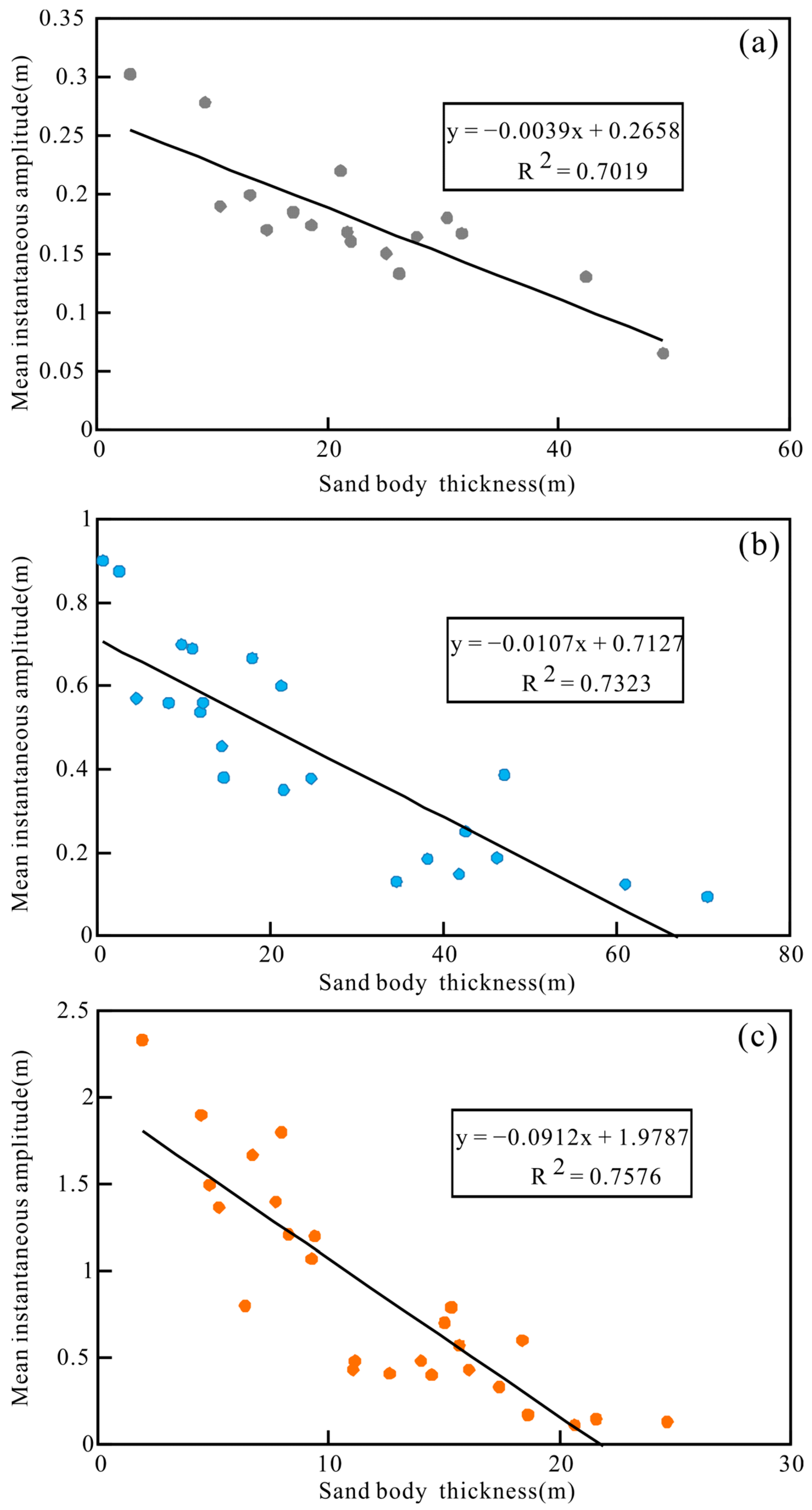

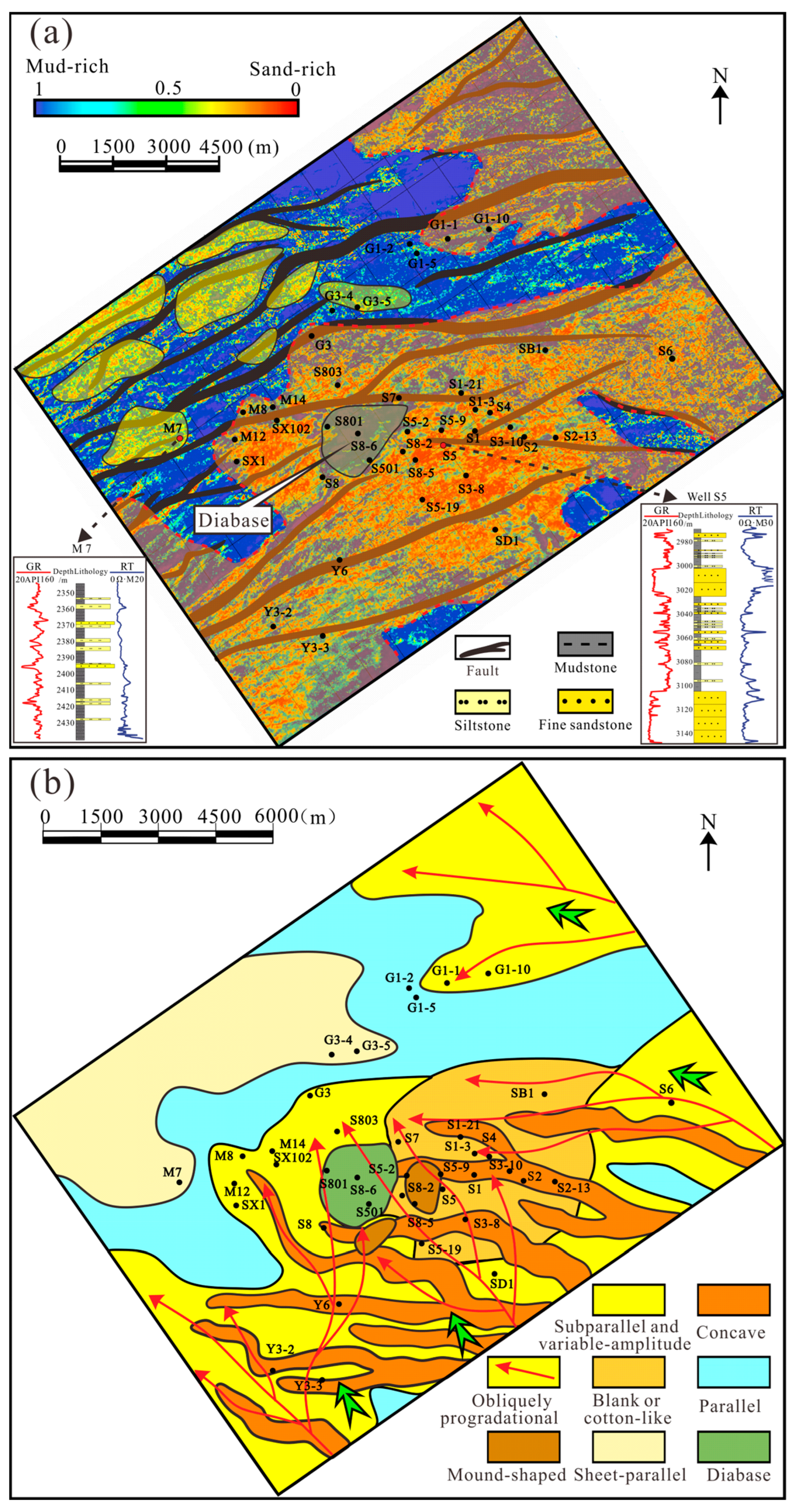
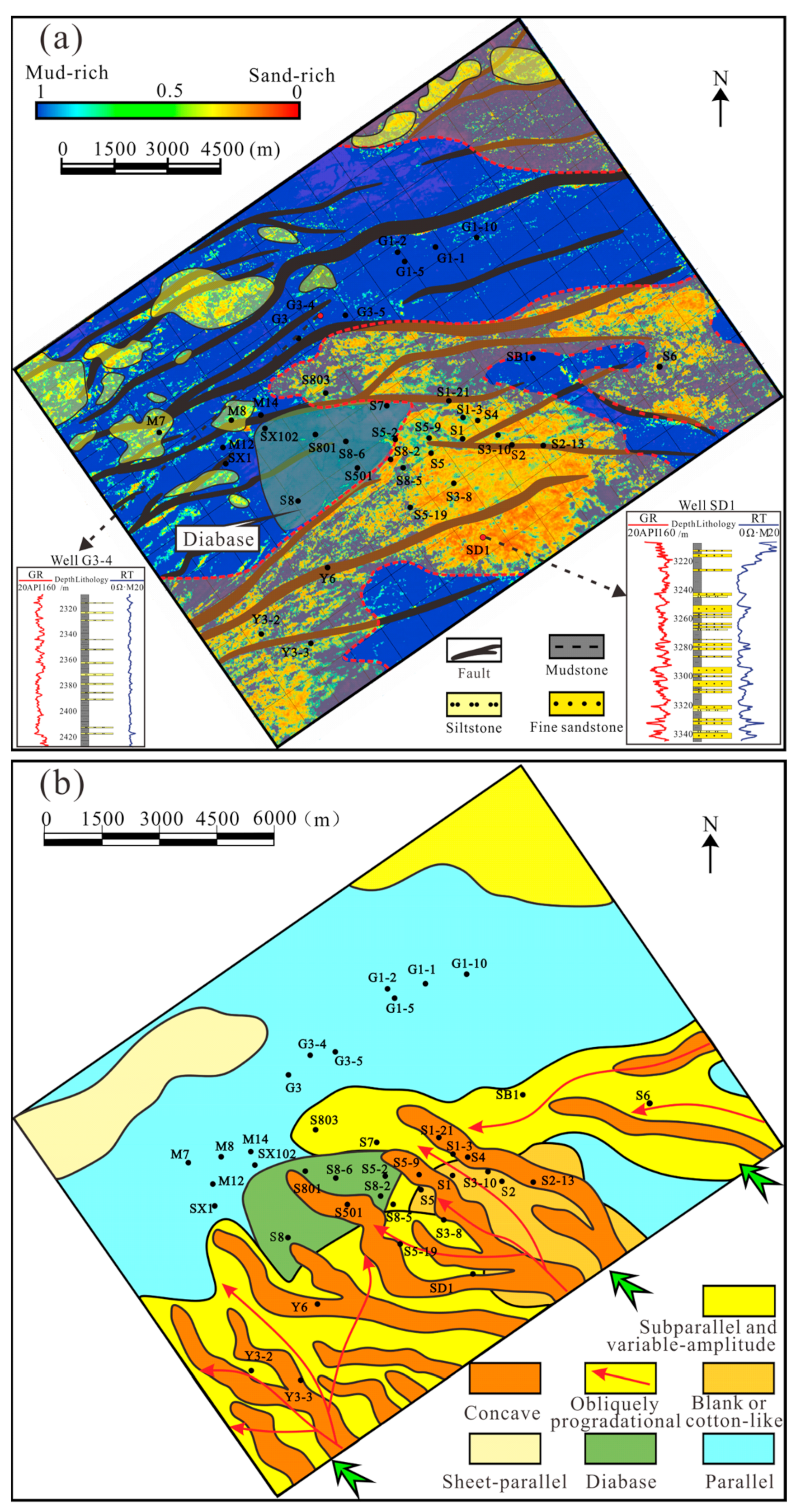
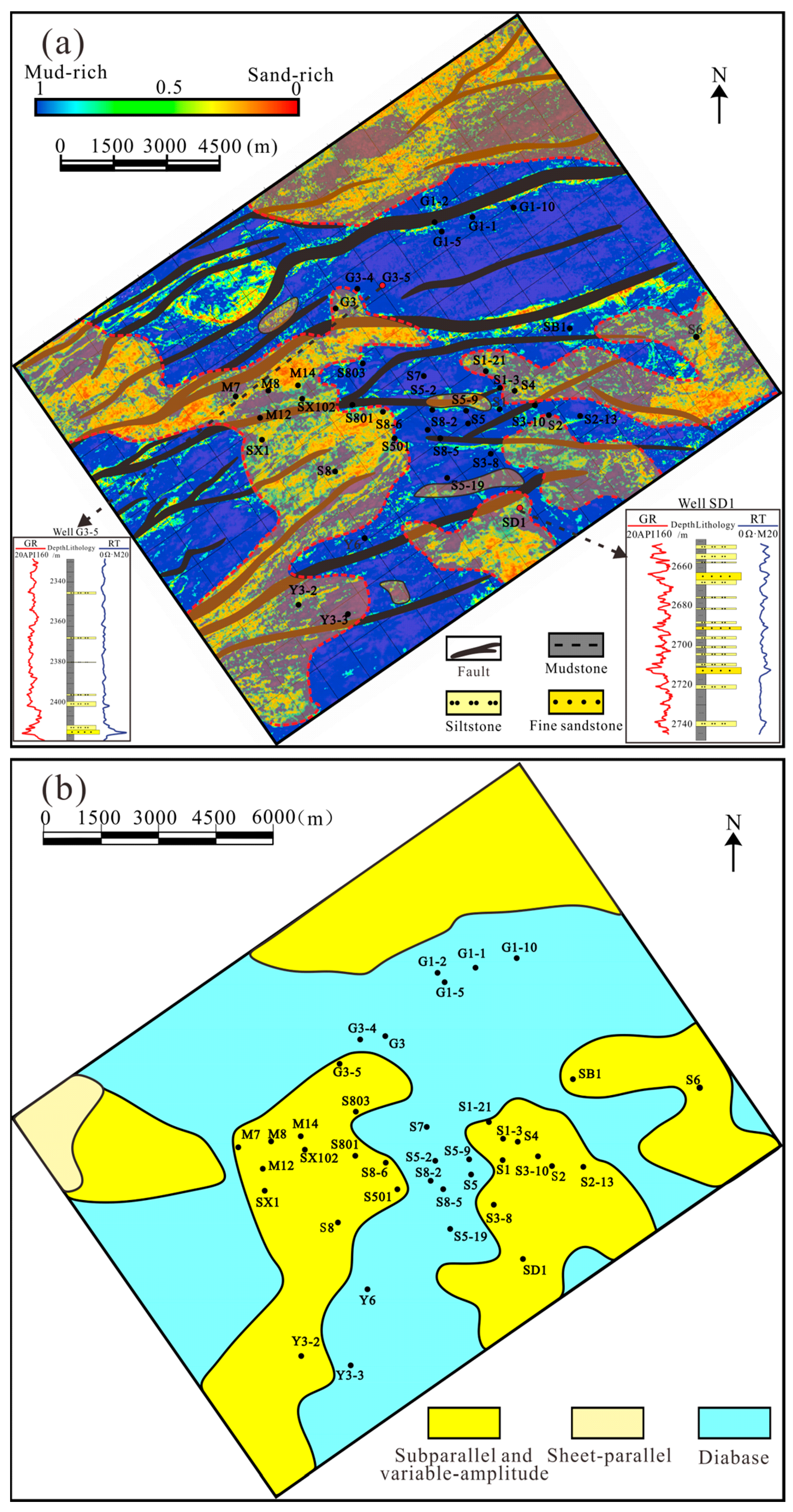
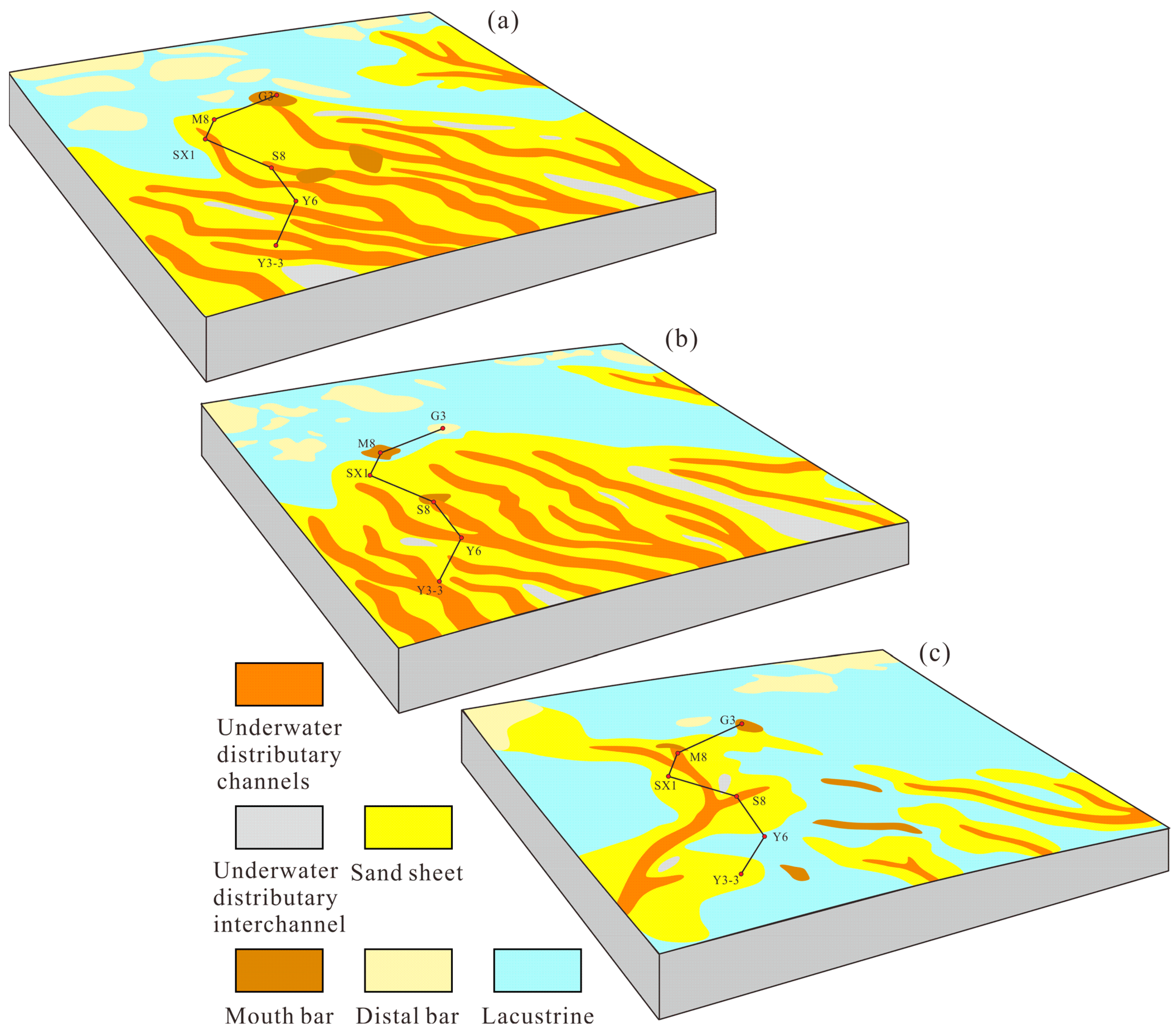
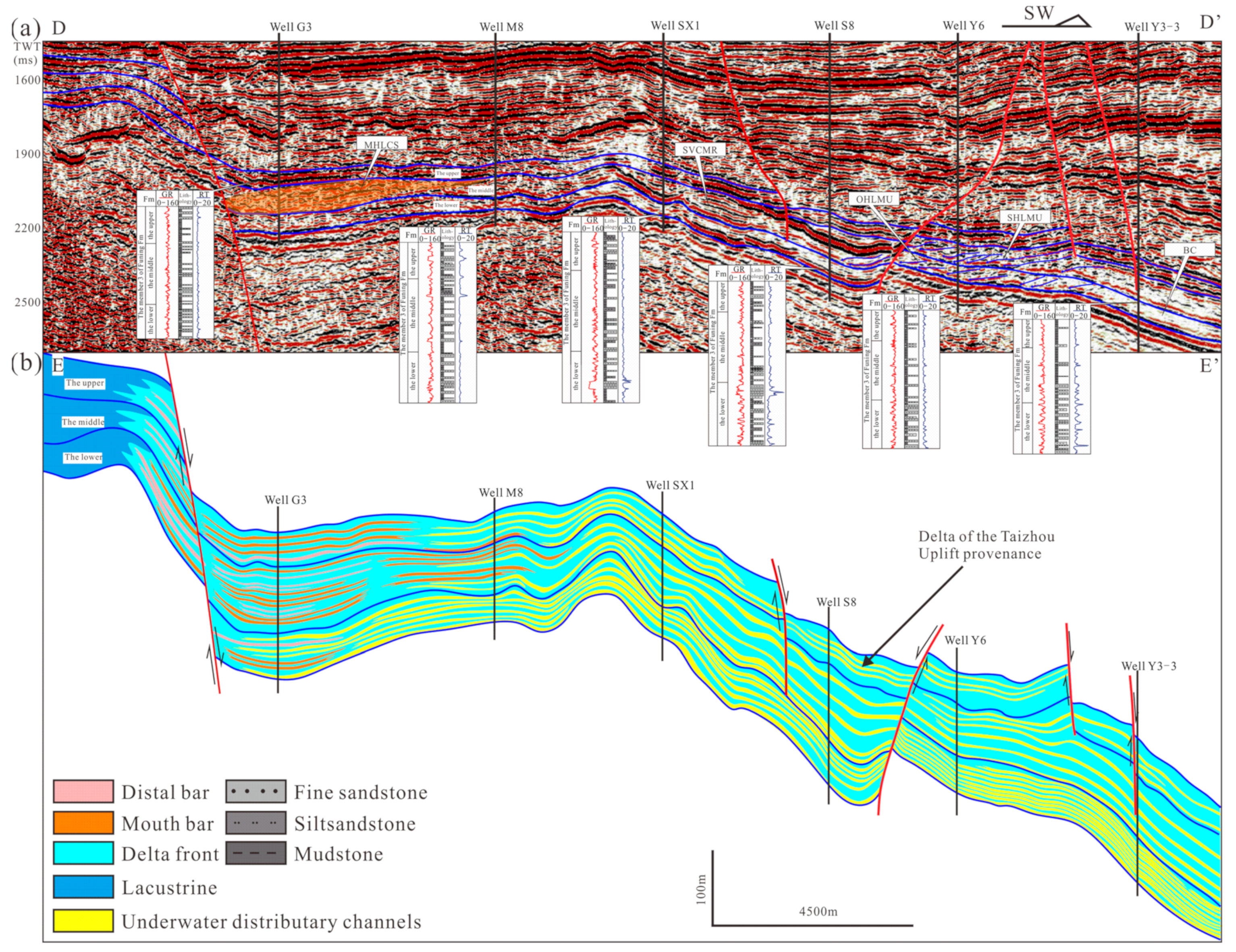
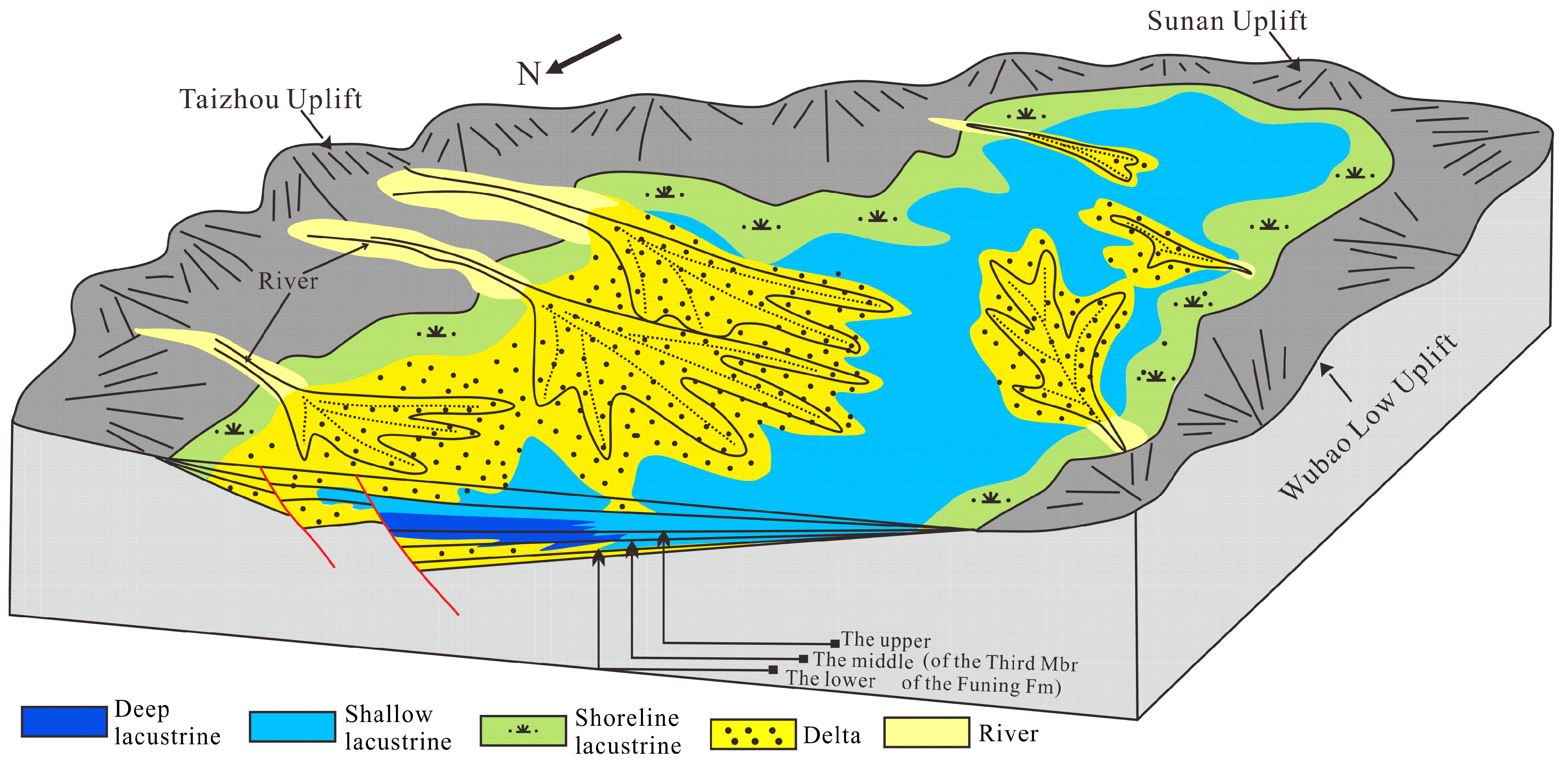
| Sample | Zircon | Tourmaline | Garnet | Mica | Epidote | Titanite | Rutile | Leucite | Magnetite | Limonite | Barite | Pyrite | ZTR | Ruzi | Gzi |
|---|---|---|---|---|---|---|---|---|---|---|---|---|---|---|---|
| C2 | 9.3 | 5.4 | 48.2 | 0.1 | 0 | 0 | 0 | 11.6 | 23.5 | 0.6 | 0 | 1.3 | 14.7 | 1.2 | 5.2 |
| C1-1 | 12.2 | 2.5 | 52.2 | 0.1 | 0 | 0 | 1.6 | 11.7 | 17.2 | 0.7 | 0.9 | 0.9 | 14.7 | 1.1 | 4.3 |
| ZS1 | 16.6 | 1.5 | 39.2 | 0.5 | 0 | 0 | 1 | 6.1 | 25.3 | 1.5 | 6.8 | 1.5 | 18.1 | 0.4 | 2.4 |
| H2 | 32.3 | 3 | 38.8 | 0.1 | 0 | 0 | 1.5 | 11.2 | 5.5 | 0.4 | 7.2 | 0 | 35.3 | 0.4 | 1.2 |
| H4 | 21.6 | 6.1 | 58.5 | 0 | 0 | 0 | 0 | 8 | 4.3 | 0.5 | 0 | 0.8 | 27.7 | 0.4 | 2.7 |
| G1 | 19.4 | 2.4 | 44.1 | 0 | 0 | 0.2 | 1.7 | 9 | 21.1 | 0.2 | 1.9 | 0 | 21.8 | 0.6 | 2.3 |
| Z2 | 17.5 | 2.1 | 59.3 | 0 | 1.3 | 0.2 | 0.5 | 13.8 | 1.3 | 2.1 | 2.1 | 0 | 19.6 | 0.8 | 3.4 |
| Y6 | 17.8 | 5.9 | 33.6 | 0 | 0 | 0 | 0 | 10.5 | 6.3 | 2.5 | 0 | 23.3 | 23.7 | 0.6 | 1.9 |
| Y302 | 39.8 | 3.8 | 29.8 | 0 | 0 | 0 | 3.2 | 13.1 | 6.8 | 2.6 | 0.8 | 0 | 43.6 | 0.4 | 0.7 |
| MS1 | 14.6 | 2.3 | 38.6 | 0 | 0 | 0 | 1.1 | 13.9 | 5.2 | 7.5 | 14.3 | 0.5 | 16.9 | 1 | 2.6 |
| CZ1-4 | 17.9 | 2.4 | 66.5 | 0 | 0.4 | 0 | 0.4 | 7.4 | 2.2 | 0.5 | 1.4 | 0.9 | 20.3 | 0.4 | 3.7 |
| HO2 | 20.5 | 1.6 | 35.2 | 0 | 3.1 | 0.1 | 1.3 | 14.1 | 3.1 | 6.3 | 5.4 | 9.4 | 22.1 | 0.8 | 1.7 |
| S161 | 20.7 | 12.6 | 43.2 | 0 | 2.8 | 1.3 | 1.1 | 14.1 | 3.7 | 2.5 | 0 | 0.5 | 33.3 | 0.7 | 2.1 |
| Well | Quartz | Feldspar | Lithic Fragments | Sandstone Petrologic Maturity |
|---|---|---|---|---|
| NH201 | 78.5 | 20.1 | 1.4 | 3.55 |
| H4 | 70.9 | 24.8 | 4.2 | 2.57 |
| H2 | 72.3 | 20.9 | 6.8 | 2.7 |
| C4 | 69.3 | 25.5 | 5.2 | 2.33 |
| Y2 | 72.8 | 24.8 | 1.8 | 2.85 |
| Z2 | 71.9 | 24.2 | 2.4 | 2.7 |
| C1 | 61.5 | 18.3 | 21.2 | 1.63 |
| Y6 | 70 | 27.2 | 2.8 | 2.33 |
| C4 | 65 | 14.5 | 20.5 | 1.84 |
Disclaimer/Publisher’s Note: The statements, opinions and data contained in all publications are solely those of the individual author(s) and contributor(s) and not of MDPI and/or the editor(s). MDPI and/or the editor(s) disclaim responsibility for any injury to people or property resulting from any ideas, methods, instructions or products referred to in the content. |
© 2024 by the authors. Licensee MDPI, Basel, Switzerland. This article is an open access article distributed under the terms and conditions of the Creative Commons Attribution (CC BY) license (https://creativecommons.org/licenses/by/4.0/).
Share and Cite
Jiang, R.; Liu, Z.; Xia, S.; Zhu, M.; Tang, J.; Wu, G.; Wu, W. A Multi-Faceted Approach to Determining the Provenance of the Lacustrine Rift Basin in the Initial Rifting Stage: A Case Study of the Paleocene Qintong Sag, Subei Basin, East China. Minerals 2024, 14, 420. https://doi.org/10.3390/min14040420
Jiang R, Liu Z, Xia S, Zhu M, Tang J, Wu G, Wu W. A Multi-Faceted Approach to Determining the Provenance of the Lacustrine Rift Basin in the Initial Rifting Stage: A Case Study of the Paleocene Qintong Sag, Subei Basin, East China. Minerals. 2024; 14(4):420. https://doi.org/10.3390/min14040420
Chicago/Turabian StyleJiang, Rui, Zhen Liu, Shiqiang Xia, Maolin Zhu, Jianxin Tang, Gongyi Wu, and Wei Wu. 2024. "A Multi-Faceted Approach to Determining the Provenance of the Lacustrine Rift Basin in the Initial Rifting Stage: A Case Study of the Paleocene Qintong Sag, Subei Basin, East China" Minerals 14, no. 4: 420. https://doi.org/10.3390/min14040420
APA StyleJiang, R., Liu, Z., Xia, S., Zhu, M., Tang, J., Wu, G., & Wu, W. (2024). A Multi-Faceted Approach to Determining the Provenance of the Lacustrine Rift Basin in the Initial Rifting Stage: A Case Study of the Paleocene Qintong Sag, Subei Basin, East China. Minerals, 14(4), 420. https://doi.org/10.3390/min14040420




